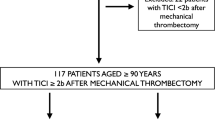Abstract
Introduction
Approximately 20–30% of the patients with acute ischemic stroke do not have any occlusion demonstrated on initial digital subtraction angiography (DSA). We sought to determine the risk and rates of cerebral infarction and favorable neurological outcome in this group of acute ischemic stroke patients.
Materials and methods
Patients were identified from a prospectively maintained stroke database and from literature search of MEDLINE, PubMed, and Cochrane databases. All patients had initial neurological assessment on National Institutes of Health Stroke Scale (NIHSS). Patients then underwent DSA after initial head computed tomography (CT) scans. Follow-up radiological assessment at 24–72 h was performed with CT and magnetic resonance imaging scans. Association of stroke risk factors with clinical and radiological outcomes was estimated.
Results
A total of 81 patients was analyzed (mean age 63 years; 28 were women). The median NIHSS score was 8 (range 2–25). None of the patients received either intravenous or intra-arterial thrombolytic. Cerebral infarction was detected in 62 (76%) of the 81 patients. Twenty-four to 48-h NIHSS was available for 51 patients only. Neurological improvement was observed in 22 (43%) of the 51 patients. Favorable outcome ascertained at 3-month follow-up was seen in 48 (59%) of the 81 patients. After adjusting for age, sex, and baseline NIHSS, male patients [odds ratio (OR) 4.5 (1.4–14.3), p value = 0.01] and patients with age ≥65 [OR 4.3 (1.2–16.2), p value = 0.03] have a higher risk of cerebral infarcts on the follow-up imaging. Similarly, patients who presented with <10 NIHSS had a better 3-month outcome than those with >10 NIHSS [OR 0.21 (0.08–0.61), p value = 0.004].
Conclusion
Ischemic stroke patients without arterial occlusion on DSA have a higher risk of cerebral infarction and disability particularly in men, patients over 65 years of age and with NIHSS ≥10. The cause of infarction may have been arterial obstruction with spontaneous recanalization or small vessel occlusion not visible on DSA.
Similar content being viewed by others
References
Kassem-Moussa H, Graffagnino C (2002) Nonocclusion and spontaneous recanalization rates in acute ischemic stroke: a review of cerebral angiography studies. Arch Neurol 59:1870–1873, doi:10.1001/archneur.59.12.1870
Mori E, Tabuchi M, Yoshida T, Yamadori A (1988) Intracarotid urokinase with thromboembolic occlusion of the middle cerebral artery. Stroke 19:802–812
Wolpert SM, Bruckmann H, Greenlee R, Wechsler L, Pessin MS, del Zoppo GJ (1993) Neuroradiologic evaluation of patients with acute stroke treated with recombinant tissue plasminogen activator. The rt-PA Acute Stroke Study Group. AJNR Am J Neuroradiol 14:3–13
Qureshi AI, Kirmani JF, Siddiqui AM, Hanel RA, Kim SH, Hopkins LN (2005) Outcomes in acute ischemic stroke patients without angiographically documented arterial occlusion. J Neuroimaging 15:37–42, doi:10.1177/1051228404270241
Arnold M, Nedeltchev K, Brekenfeld C et al (2004) Outcome of acute stroke patients without visible occlusion on early arteriography. Stroke 35:1135–1138, doi:10.1161/01.STR.0000125862.55804.29
Derex L, Tomsick TA, Brott TG et al (2001) Outcome of stroke patients without angiographically revealed arterial occlusion within four hours of symptom onset. AJNR Am J Neuroradiol 22:685–690
Slivka AP, Christoforidis GA, Bourekas EC, Calendine PE, Notestine MA (2005) Clinical and imaging outcomes after stroke with normal angiograms. AJNR Am J Neuroradiol 26:242–245
Wolfe CDA (2000) The impact of stroke. Br Med Bull 56:275–286, doi:10.1258/0007142001903120
del Zoppo GJ, Higashida RT, Furlan AJ, Pessin MS, Rowley HA, Gent M (1998) PROACT: a phase II randomized trial of recombinant pro-urokinase by direct arterial delivery in acute middle cerebral artery stroke. PROACT investigators. Prolyse in acute cerebral thromboembolism. Stroke 29:4–11
Conflict of interest statement
We declare that we have no conflict of interest.
Author information
Authors and Affiliations
Corresponding author
Rights and permissions
About this article
Cite this article
Shah, Q.A., Zeeshan Memon, M., Vazquez, G. et al. Clinical and radiological outcomes of acute ischemic stroke patients without angiographic occlusion on digital subtraction angiogram. A pooled analysis of case series. Neuroradiology 50, 963–968 (2008). https://doi.org/10.1007/s00234-008-0449-8
Received:
Accepted:
Published:
Issue Date:
DOI: https://doi.org/10.1007/s00234-008-0449-8




